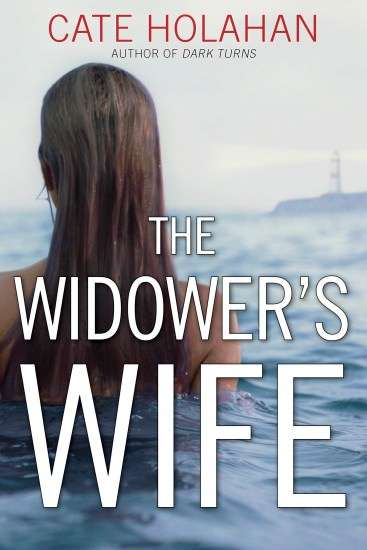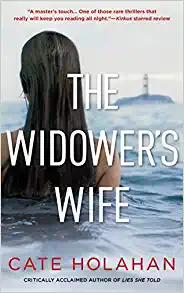The Widower’s Wife by Cate Holahan
The opening lines to Cate Holahan’s The Widower’s Wife (Crooked Lane Books, August 9, 2016) solidified my perpetual refusal to go on a cruise ship. Her newest thriller follows the investigation of a young wife gone missing on a cruise and she just so happens to have a lofty inheritance. Ryan Monahan, a character I’m dying for Holahan to feature in future work, is on the case to find out what happened to Ana Bacon. Her follow-up to her debut novel, Dark Turns, took me on a weaving narrative to the aftermath and the events leading up to the mysterious woman’s disappearance.
Perspective is reality, as the tired, ever-relevant saying goes. For the One Question and Answer series, I asked her about the importance of establishing point of view.
Question: Perspective is important in The Widower’s Wife with the alternating points of view between investigator Ryan Monahan and Ana Bacon, the woman who’s gone missing. What steps did you take to differentiate the voice of each alternating chapter and what challenges did you face throughout the writing process?
 Cate Holahan: Ryan Monahan is a numbers man. He remembers statistics and odd facts. He makes decisions after carefully considering the odds of success. He’s the kind of guy who would have looked at the over-under of financial success as a novelist and surely ruled out a writing career.
Cate Holahan: Ryan Monahan is a numbers man. He remembers statistics and odd facts. He makes decisions after carefully considering the odds of success. He’s the kind of guy who would have looked at the over-under of financial success as a novelist and surely ruled out a writing career.
I am nothing like Ryan Monahan. So, how do I write a main character who is so different from myself and stay true to his voice when his world view, backstory and mannerisms are so unlike my own? And how do I keep him straight when every other chapter is from the perspective of a woman who is far more similar to me though with a different backstory that makes her capable of acts which I could only dream up.
My answer is acting. I ready myself for writing my characters like an actor prepare for a part. Then, I use that preparation to immerse myself in the perspective from which I am writing.
Before writing The Widower’s Wife, I read famous acting teacher Constantin Stanislavski’s trio of books on building characters to glean tips on getting into the right frame of mind to play a particular person. One of these tips is to know not just the lines on the page but the character’s backstory. Though this story may never make it into the novel or script, it is key to understanding how the character would react in certain situations. Often, it must be invented.
I wrote backstories complete with childhood experiences and formative adolescent events for both my characters. Some of Ana’s history makes it into the novel. Ryan’s childhood remains in head alone as only recent events are alluded to in the book. Knowing how both of my characters grew up allowed me to imagine how their different histories would inform their actions.
I also develop psychological profiles for my protagonists. Ryan, as he guesses in the first chapter of the book, may have a touch of Asperger’s Syndrome. He uses facts and logic to figure people out and determine likely occurrences. Because he is a relatively staid guy, he sometimes misses clues that wouldn’t make sense unless a person was behaving in an overly emotional, erratic fashion. Dogged investigator that he is, though, he eventually figures things out.
Ana, while a high functioning person in many respects, has some serious damage to her psyche. She suffers from abandonment issues due to her parents’ deportation that have fueled codependent behavior. Too easily, Ana subordinates her own desires to those of her spouse and child. The lengths that she goes to keep her family together stems from the adolescent trauma of having her parents taken away.
After I have my characters’ psychological profiles and backstories down, I cast my tale with people that look like my characters, scouring the web for images and videos featuring my imaginary people. The backstories are key to this search. Ana, an American-born child of poor Brazilian immigrants, is not going to resemble Scarlet Johansson. Brazil is a very diverse country with many fair, blonde, blue-eyed people. However, the Brazilians most likely to decamp for the United States for financial reasons tend to be members of the lower middle class. The poorest Brazilians, who are primarily of Afro-Brazilian descent, cannot afford to move. The lower middle class in Brazil, according to statistics, is largely made up of people with diverse ethnic heritage. Ana, as a result, is a multi-ethnic woman. In my head, she’s a combination of City of God actress Alice Braga and model Camila Alves. But readers can mentally cast a number of multi-ethnic women in her role.
Ryan is an Irish-American cop. I thought of Ed Burns or Edward Norton. It helps me, sometimes, to think of famous faces when writing because I can more easily imagine a variety of expressions on those faces. And, if I can’t imagine them, I can probably find a YouTube video somewhere. Personally, I try not to pick actual people from my life as the visual models for my characters because I don’t want anyone reading a scene where, say, the guy’s wife cheats on him and think does she know something I don’t?
Finally, before I write, I find a song that gets me in the mood the character. For Ana it was Florence and the Machine’s Never Let Me Go. The song is about a woman seeking deliverance, and possibly drowning, in the ocean. When discussing the song with a Newsweek reporter, Florence Welch shared a thought about children drowning in the ocean. Often, she said, a parent will swim out to save the child and then, because the adult is much heavier than the kid, the parent is pulled down by the undertow while the child is swept back to shore. As any reader of The Widower’s Wife—or even the back of the book blurbs—will know is that the idea of a parent doing everything to save her kid and drowning in the process is definitely relevant to Ana. The music put me in the correct frame of mind to write about her.
When writing Ryan’s character, I listened to Mozart. As a math guy, I thought he’d appreciate the structure and form of Mozart’s classical pieces. When Ryan was having a particularly bad day, I’d play Requiem in D before sitting at my computer.
Thanks to all this preparation, keeping perspective wasn’t difficult when I actually sat down to write. In fact, some days I felt that Ana and Ryan wrote their own stories.
Buy this Book!
Amazon




